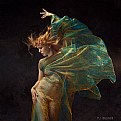| Photography Forum: Photography Help Forum: |
 |
Q. Exposures with Studio Lights

Asked by Christopher Robinson
(K=139) on 10/14/2006
|
Hi,
I have new studio lights with a Sekonic light meter that's equipped with the wireless transmitter that sets my lights off. The problem is that anytime I meter a shot, the photos still come out overexposed. All the details are washed out. I've been taking the meter reading and going with -1 exposure setting. This light meter has been incredibly accurate with any other situation. So what gives?
Do you all have any advice on how to get perfect exposures with studio lighting set ups? I've looked for books and articles on this, but there doesn't seem to be diddly squat on this subject. I would greatly appreciate any helpful advice.
Thanks much!
C
|
|
|
|
|
|
|

Christopher Robinson
(K=139) - Comment Date 10/14/2006
|
Oh. I'd like to add that even the -1 exposures still don't come out crystal clear with the details. Perhaps I need to set my lights further away from my subjects? Or maybe it's too strong? I've read about the light guide numbers, but from what I understand, that should all be okay.
Cheers.
|
|
|
|

Phillip Cohen
 (K=10561) - Comment Date 10/14/2006
(K=10561) - Comment Date 10/14/2006
|
Christopher, where are you placing the meter when you are taking the reading and where do you point the white dome. You should place the meter at the subject and aim it at each of the lights that you are using. Make sure that the proper iso and shutter speed is set into the meter. You should then set your aperture to what your meter says.
Phil
|
|
|
|

Christopher Robinson
(K=139) - Comment Date 10/14/2006
|
Hi Phil,
Thanks for your response. I have been placing the meter right in front of the subject, however, I haven't been taking individual meter readings for each light/directed at each light. That might just be the problem, or at least a large part of it. The rest, I just do what the meter says. I will definitely give this a try with making sure both lights are equal or within the acceptable exposure range! ;-) THANKS!!
Do you know if there's a specific distance a light should be from the subject? I've been placing mine (1200w each) 6, 9, and 12 feet away from the subjects. All I've understood from the lighting guide system is that the guide tells you the furthest distance you have to be in order to get that strength of light. How do you know what the closest distance is? Or should that typically be reflected in the light meter? Because technically, with everything else, the light meter has always been correct... and has always matched (with only slight variations) the required exposure settings.
Sorry to ramble. Maybe this is all about pointing the dome at each light.
Thanks again!
C
|
|
|
|

Phillip Cohen
 (K=10561) - Comment Date 10/14/2006
(K=10561) - Comment Date 10/14/2006
|
Christopher,
There is no closest distance, it all depends on how much light hits your subject. When I shoot portrait headshots, I put the main light, a translucent umbrella, as close to the subject as I can get it, just outside of the camera view. I vary the power either with the power pack or using neutral density gels to get the exposure that I want.
Some basic lighting theory here. The farther away the light is from the subject, the smaller it will appear. This not only effects the amount of light hitting the subject as it drops off based on the square of the distance, but it also effects the quality of light hitting the subject. If you have the light far away, the relative size of the light is smaller meaning the light will be harsher and contrastier causing deeper shadows. The closer the light, the larger it is relative to the subject, meaning less contrast and softer shadows. Take a look at the sun at noon, it is a small light source and notice how deep the shadows are and how contrasty things look. Now look at the light on an overcast day the light is diffused over a large area, the shadows are softer and scene contrast is much lower. This is the equivalent of using a bare light vs a diffused light such as a shoot through umbrella or softbox.
Post one of your pictures here in the forum so we can see what you are doing and how you are lighting the subject.
Phil
|
|
|
|
|
















